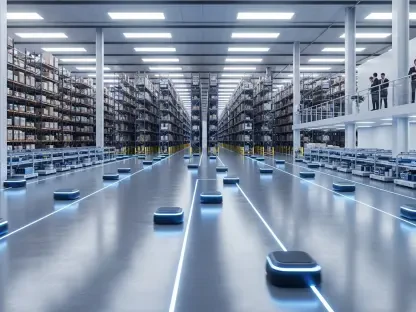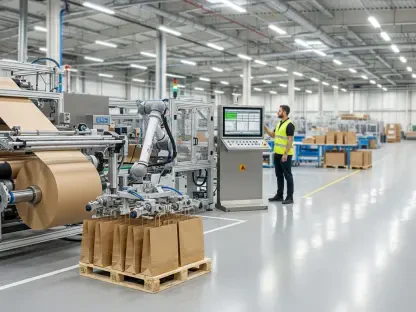The rapid expansion of artificial intelligence (AI) has sparked a staggering statistic: data centers powering AI systems currently account for about 1.5% of global electricity consumption, with projections suggesting this could double by 2030, according to the International Energy Agency. This immense energy appetite raises critical questions about sustainability at a time when climate goals demand urgent action. Yet, AI also holds transformative potential to curb emissions and optimize energy use across industries. This roundup dives into diverse perspectives from industry leaders, researchers, and innovators to explore how AI can strike a balance between its heavy energy footprint and its promise as a tool for environmental good, uncovering insights and strategies to tip the scales toward a greener future.
Unpacking the AI-Environment Tension
The relationship between AI and environmental sustainability presents a complex paradox that has drawn attention from multiple sectors. On one hand, the computational power behind AI, driven by sprawling data centers, consumes vast amounts of energy, often sourced from fossil fuels. On the other hand, the same technology offers solutions to reduce carbon footprints through smarter systems. This roundup compiles varied opinions to assess whether AI can evolve into a net-positive force for the planet.
Industry voices highlight the pressing challenge of energy consumption as a primary concern. Many point out that without strategic interventions, the escalating demand for power could undermine global efforts to combat climate change. The consensus leans toward the need for innovative approaches to mitigate this impact, setting the stage for a deeper exploration of both problems and possibilities.
A contrasting viewpoint emerges from technology optimists who emphasize AI’s capacity to solve the very issues it creates. They argue that with the right focus, AI can drive efficiencies that outweigh its drawbacks. This duality forms the core of ongoing debates, prompting a closer look at specific applications and expert insights.
The Energy Burden of AI Technologies
Scaling Energy Demands and Their Implications
The energy footprint of AI systems, particularly through data centers, remains a significant hurdle. Reports indicate that if current trends persist, electricity usage by these facilities could surge dramatically over the next few years, potentially increasing reliance on non-renewable energy sources. Industry analysts express concern that this growth might exacerbate greenhouse gas emissions at a critical juncture for climate action.
Some researchers caution that the environmental cost of AI could overshadow its benefits if unchecked. They advocate for immediate action to shift data centers to renewable energy sources, highlighting that without such transitions, the carbon impact will continue to grow. This perspective underscores a sense of urgency in addressing infrastructure challenges.
A slightly more balanced view comes from tech sector observers who acknowledge the issue but point to emerging solutions. They note that advancements in hardware efficiency and cooling technologies are already reducing energy needs in some facilities. This suggests a pathway to lessen the burden, though widespread adoption remains a key obstacle.
Counterarguments on Efficiency Gains
Despite the heavy energy toll, certain experts argue that AI’s efficiency is improving at a pace that could offset rising demands. They reference innovations in chip design and algorithmic optimization as critical developments that reduce power consumption per computation. This angle offers a glimmer of hope amid growing concerns.
Others in the field stress that efficiency gains alone may not suffice without systemic changes. They argue for policies that incentivize green energy adoption in AI operations, suggesting that technological progress must align with broader sustainability frameworks. This viewpoint calls for a multi-pronged approach to tackle the issue.
A third perspective focuses on the role of corporate responsibility. Some industry leaders believe that tech giants driving AI development have the resources to pioneer sustainable practices, setting standards for smaller players. This opinion shifts part of the burden to influential stakeholders to lead by example.
AI as a Catalyst for Environmental Solutions
Optimizing Energy in Buildings and Beyond
AI’s potential to enhance energy efficiency garners significant attention, particularly in building management. Insights from tech innovators reveal that automated systems using AI can cut energy use by 10% to 30% by adjusting lighting, heating, and cooling based on real-time data. Such applications are seen as low-hanging fruit for immediate impact.
Another angle comes from urban planners who note AI’s broader implications. They highlight pilot programs that integrate AI into city-wide energy grids, optimizing consumption across multiple sectors. This perspective emphasizes scalability as a crucial factor in maximizing environmental benefits.
A more cautious stance emerges from some analysts who warn that adoption rates for these technologies lag behind potential. They argue that without significant investment and policy support, many of these solutions risk remaining niche rather than mainstream. This concern points to structural barriers that need addressing.
Revolutionizing Renewable Energy Exploration
In the realm of clean energy, AI is hailed as a game-changer by many in the sector. Tools leveraging machine learning are unlocking renewable resources like geothermal energy, with successful discoveries reported in regions such as New Mexico and Nevada. Enthusiasts view this as evidence of AI’s ability to accelerate the transition to sustainable power.
Some energy experts, however, temper this optimism with practical concerns about scalability. They note that while early results are promising, the infrastructure and funding required to expand these initiatives globally are substantial. This viewpoint calls for realistic timelines and resource allocation to match the hype.
A different take focuses on the long-term vision for AI in renewables. Certain thought leaders suggest that as data models improve, the precision of identifying and harnessing clean energy sources will grow, potentially reducing costs. This forward-looking stance encourages patience alongside investment in research.
Cutting Emissions Through Urban Innovation
AI’s role in urban sustainability offers another promising avenue, with projects like traffic signal optimization reducing emissions by up to 10% in select cities. Urban tech advocates praise these initiatives for tackling everyday sources of pollution, such as vehicle idling, with data-driven adjustments.
Contrasting opinions surface from municipal planners who question the pace of integration into smart city frameworks. They argue that while pilot programs show results, broader deployment faces hurdles like budget constraints and technical expertise. This highlights a gap between innovation and implementation.
A third perspective from environmental consultants stresses the ripple effects of urban AI applications. They suggest that beyond direct emission cuts, these systems can influence public behavior, encouraging greener habits over time. This angle adds a social dimension to the technological discussion.
Strategies for Harmonizing AI with Sustainability
Drawing from diverse insights, a key strategy lies in prioritizing AI investments in high-impact areas like building automation and renewable energy exploration. Many experts agree that focusing resources on sectors with immediate environmental returns can help offset AI’s energy costs. This targeted approach is seen as a practical starting point.
Another recurring recommendation involves advocating for policies that promote energy-efficient technology development. Voices from both academia and industry underscore the importance of regulatory frameworks that incentivize green practices in AI operations. Such measures are viewed as essential to align innovation with ecological goals.
A final tip from sustainability advocates centers on public awareness and engagement. They propose that supporting initiatives aligned with renewable energy and staying informed about industry advancements can drive collective momentum. This grassroots perspective complements top-down strategies for a holistic impact.
Reflecting on the Path Forward
Looking back on this roundup, the discussions revealed a nuanced landscape where AI stands as both a challenge and an opportunity for environmental sustainability. The insights gathered from various sectors painted a picture of cautious optimism, balancing the stark reality of energy demands with tangible successes in emission reductions and efficiency gains. Moving forward, stakeholders are encouraged to champion AI innovations that prioritize renewable energy integration, ensuring technology serves as a steadfast ally in combating climate change. A critical next step involves fostering collaborations between tech developers and policymakers to create scalable, sustainable solutions that could redefine AI’s role in shaping a healthier planet.









